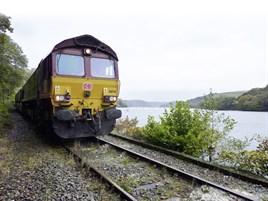RAIL is here to see 66176 in action. This is the first DB Schenker locomotive to be successfully fitted with stop-start technology (RAIL 758).
The Auto Engine Stop Start (AESS) technology, manufactured by ZTR, will be fitted to 30 locomotives by the end of this year, and a further 60 in 2015. By the end of 2016, all 174 DB Class 66s based in the UK will be fitted with the technology.
DB Head of Maintenance and Infrastructure Andy Byrne says the move will save 4,500 tonnes of carbon emissions per year across the first 90 Class 66s. Tests on 66176 showed that the amount of time the engine was running was reduced by about one-third, cutting CO2 emissions by more than 50 tonnes (thus equating to the 4,500t for the 90 locomotives, a 10% reduction in emissions).
DB fitted the equipment to 66176 in February, and it has remained in Cornwall ever since, with the exception of when it has left for maintenance.
Byrne says AESS works like a modern car. A box (250mm long, 200mm high and 80mm deep, mounted in a small pre-existing and unused cabinet located in the vestibule behind No. 1 cab of the locomotive) is fitted to the ‘66’ with specific parameters set, regarding performance.
When the ‘66’ comes to a stand and begins to idle, the box will measure battery voltage, engine temperature and oil temperature. If these measurements meet the parameters, then the ‘66’ shuts down.
When power is applied, the ‘66’ will then take 10-20 seconds to ‘fire up’ and start moving. Byrne says this will not add time to journeys, because it is not a complete engine shutdown - some systems will still be operating.
Since receiving AESS, the ‘66’ has used 20,000 litres per year less than usual. Over the entire fleet of 174 locomotives, that represents a saving of almost 3.5 million litres.
Byrne says it has been deployed to Cornwall because the flows there use one depot (St Blazey), and there is a small team of drivers who are thus able to offer detailed feedback.
On the day of RAIL’s visit (October 15), it is working from Goonbarrow to Fowey Docks. In terms of distance this is a short journey, but it will take longer because the ‘66’ must run to Lostwithiel and then run round before heading down the Fowey branch. The latter is short (only four miles), and described by Hutchinson as a “gentle trundle”.
He notes that there have been a couple of issues with the technology on the ‘66’, but nothing major, merely what he calls “usual electrical equipment” faults. There were also a couple of problems with it firing up (but again nothing major), while the project leader has also been to Cornwall to reprogramme the ‘66’, following driver feedback.
While at St Blazey, Hutchinson tells RAIL: “It will shut down at Fowey and it may also do so at Lostwithiel.” He says the restart is “almost instant”.
In terms of training the drivers, Hutchinson says: “There was a briefing pack, but that was relatively short. There is not a lot to it.”
He says the system can be over-ridden, allowing the driver to dictate its use. This is useful in winter, because if the locomotive is employed on a possession then a driver does not want to be sat in a cold cab, so he can ensure that the engine is still running.















Login to comment
Comments
No comments have been made yet.